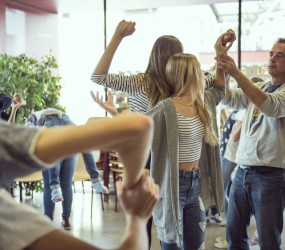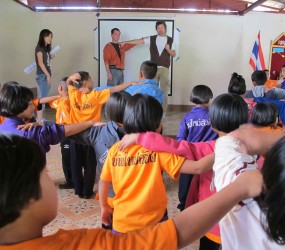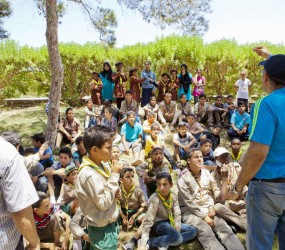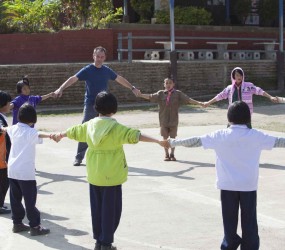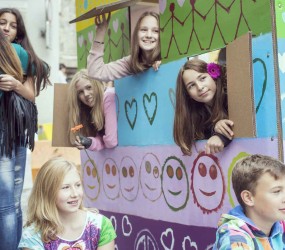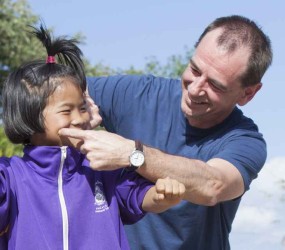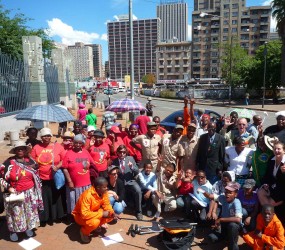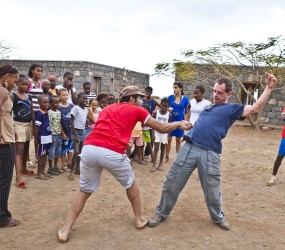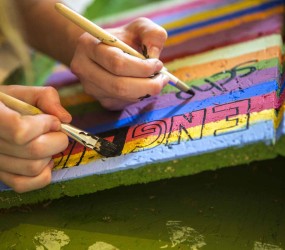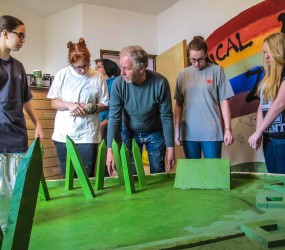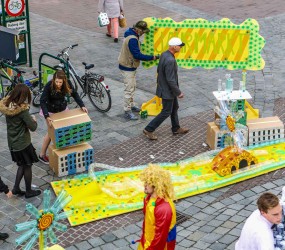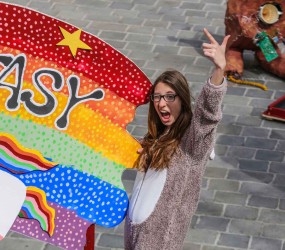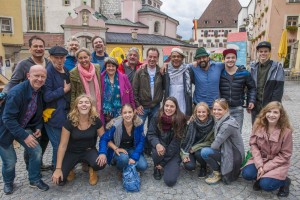 CHILD OF PLAY is merging a constantly growing team of international artists and educationalists convinced, encouraged and knowing that playing and art are the tools to build confidence and to open the mind of children and youth.
CHILD OF PLAY is merging a constantly growing team of international artists and educationalists convinced, encouraged and knowing that playing and art are the tools to build confidence and to open the mind of children and youth.
The aim of this educational approach is to reach a sustainable result in children’s and young people’s development. CHILD OF PLAY intends to develop and realize innovative educational art-projects with and for the young generations.
Our “creativity & learning” approach will stimulate participants to shape independent thought processes and inspire them in free and creative forms of artistic expression at the same time generating this togetherness, only which makes this exceptional approach and results happen and possible.
The core topic is presented to the young people by the artistic team and from there the process takes shape through discussions, questions, brainstorming, drawings, designs and making, after which a common interpretation and vision will be translated into reality through the power of imagery.
The entire process is based on different creative workshops and only by combining them a final goal can be reached through empathy, commitment and a work ethos, allowing the children and youth to express them-selves on something, which is bigger than them, both physically and intellectually.
Our objectives are carried out through long term related initiatives where art and culture instills values in a spirit of togetherness. It is also a call to action that aims at crossing borders and going beyond gender and cultural differences by giving the children a “voice” through the power of their own imagination, their creativity and their own dreams. Our task is to offer a vehicle that utilizes our professional skills, our experience and our conviction to set off a creative process with the youth & children.
General goal of the workshop program
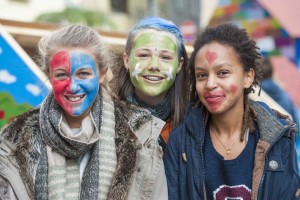 The children and youth are working collaboratively as part of a team, with peers and adults for the goods of a final result. This develops their social skills, talking and discussing ideas and listening to others points of view.
The children and youth are working collaboratively as part of a team, with peers and adults for the goods of a final result. This develops their social skills, talking and discussing ideas and listening to others points of view.
Through playing, they will learn how to act in a group, when to voice their own opinions and when to listen to others. More importantly, they will do so by own experience, which is the most significant type of learning there is.
The artistic team is working with children and young people developing their design, drawing, making and painting skills, thus allowing them to build on their thinking and manual knowledge.
As this whole workshop program will also be happening in an informal and free context of constant sharing and cooperation, the team of instructors and the children will have several moments of reunion, whether eating, playing together, preparing meals or just relaxing and chatting.
Also during these moments, the instructors will be talking to the children about human values and specifically Children’s rights and the importance of playing and taking part in cultural activities.
This is the main goal of the entire process, that children and young generations who play with us and we are able to work with, are aware of and learn about essential human values and their own rights.
All our educational art-projects have this central background, which we explain in details to the young people to encourage them to stand up for values and rights, their future. Sharing with them at the same time, that it is them-selves who are able spread this awareness, also through a common project like this.
Workshop program possibilities
1) Introduction & play workshop / presentation activity
Introducing everyone in the group, including the instructors and artists, creates an atmosphere of trust and familiarity, which are vital to develop the kind of comfort and security needed for the expressive activities that follow.
There are various ways (f.e. circle-games) to do this in playful and funny ways, involving all children/youth in the group including all artists/educationalists – it is also about sharing the importance of simply “playing” with the children and youth (group playing activities).
As a second step within this intro-workshops human values, human rights and children rights based on the United Nations declarations and statements are introduced and a related core topic is presented to the young people by the artistic team and from there the process takes shape.
2) Theatre workshops
Role-play
By using a very familiar universe for the child as a base to these activities, each child will develop its improvisation skills. This familiarity will allow them to feel more comfortable with the subject at work, as they will most likely see it as a funny game and forget that they are being observed.
Also here various exercises and creative approaches are possible to offer joy and fun to the participants.
Acting
As with the role-play activity, the main goal is to make the children as comfortable as possible with being in the spotlight. By presenting their own work in front of a known audience, they will strengthen their sense of confidence and self-esteem as well as their improvisation skills. Furthermore, it makes them comfortable with talking in front of a large group, which in turn helps them build a stronger sense of empowerment.
As the role of the characters will display different emotions, the children will also work on their expressiveness. This allows them to get in touch with their own emotions, reflect on the characters feelings and make a connection with the text they are reading or symbolic they are expressing. This, in turn, will improve their interpretation skills as well as their motivation to read more texts and diversify the type of text they read as to learn about symbols and meanings.
As these exercises will be referenced again in future activities, which lead to a final result, the children will also work on their memorization skills.
3) Interview workshop / Language development
By interviewing adults or other children/youth, the young people will learn how to conduct an interview, how to build a questionnaire and the social rules that apply to a bilateral discussion (normally the kids are used to a unilateral discussion, where the teacher or parent speaks and they listen, so this is a huge improvement also to their own empowerment skills). By recounting the story of their interview to the workshop group, the children will be improving their memorization and recollection skills, as well as their ability to speak in front of a group of spectators.
Furthermore, in cases where the language in which the children heard the story is not the same as the one in which they will be recounting it, the brain elasticity and the meta-linguistic skills needed for this task are of great importance to the brain development of the child.
4) Costume design workshop
 By planning their own costume related to a character involved in the core topic, the children will be working not only on their creativity but also on their critical thinking: “Is this easy for me to make? Can I find this material in my house/school/community?” These questions will help them self-evaluate their work.
By planning their own costume related to a character involved in the core topic, the children will be working not only on their creativity but also on their critical thinking: “Is this easy for me to make? Can I find this material in my house/school/community?” These questions will help them self-evaluate their work.
As the construction of the costume requires some planning, the children will be working on their organization skills, as well as their planning, time management and expectations.
Lastly, as the planning skills of a child are very likely to not be entirely successful, they will learn to deal with their frustration and managing their own emotions for the good of the end result and for the good of the group work.
5) Set building workshop
 The children/youth are invited to develop their creative ideas, visions and illusions to a specific theme defined by the artistic team and related to a targeted final vision. Depending on the age of the participant children/youth the artistic team will support this process.
The children/youth are invited to develop their creative ideas, visions and illusions to a specific theme defined by the artistic team and related to a targeted final vision. Depending on the age of the participant children/youth the artistic team will support this process.
The artists will view all the sketches and create a mixture of all ideas to define a set building based on the children’s/youth’s creativity where everybody can find his/her inputs later on again.
Once the set is designed by general agreement of children and adults, the artists will let the children know which tasks are open for them to do and build. The smaller children can help with drawing and painting, while the older children can help with wood work, sanding, nailing, cutting, sowing, etc.
By applying work techniques that can be potentially dangerous, the children learn the safety rules they need to follow in order to make their work place a safe environment for themselves and for others.
As these tasks are also very precise, the children will also be working on their concentration and fine motor skills.
Furthermore, by applying different techniques and observing others doing them, the children learn those techniques, how to apply them, what tools to use and which conditions are needed to produce a good result. A result, which only becomes possible if working all together for!
6) Photography and video workshop
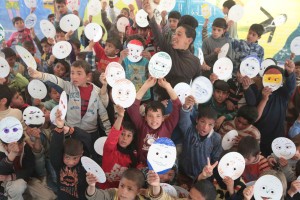 With these activities the children create a connection with the universe of photography and filming, while apprehending basic technical concepts related to these forms of art and stimulating their creativity.
With these activities the children create a connection with the universe of photography and filming, while apprehending basic technical concepts related to these forms of art and stimulating their creativity.
Furthermore, by turning the theory into practice right away, their learning becomes more significant and their motivation to stay focused enhances.
The given exercises within this workshop always are related to the main themes of the entire project and do include cultural aspects to be shown through the eyes of the participants.
Also a connection between the interview workshops and the video workshops are relevant to the concept to work and to create one final goal and result driven by the possibilities offered to the children and youth.
7) Translating emotions into pictures/videos
This workshop (also related to photo/video as to the theatre workshop) is about the ability of translating emotions with our bodies and the capacity to capture them in images. As a second phase of this exercise, the instructors will also show that the emotion doesn’t only have to be translated in the body language of the model, but that an image without any live object can also transmit emotion.
As an very important side effect through this exercises, the children will gain greater control of their own bodies and understand that the image they send out is not always the one they have in mind. This is of great importance not only for the art of photography/film, but to their own sense of empowerment, as they will be more aware of their body language in different social situations.
Especially for girls, this is an extremely important concept, so they can make themselves safer in their own environment, by understanding that something as simple as a piece of clothing can send the wrong message and potentially put them in a dangerous situation.
8) Music workshop
We are very much aware of that there are astonishingly music concepts for educational use – this is about collective development of harmonies, songs from all cultures, collective singing, understanding music structures and the power of music to heal trauma.
Child of Play is happy to announce the development of these workshops together with the musician and psychosocial specialist Wassim Mukdad (see “performers”) in near future.

